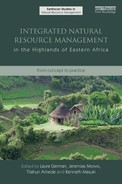BOXES
2.1 Optimization of enset-based systems for enhanced food security in Ethiopia
2.2 Examples of entry points used in addressing more complex system constraints in southern Ethiopia
2.3 Tomato varieties meeting market requirements—a successful entry point in Lushoto BMS
2.4 Use of farmer field schools in promoting potato-related innovations in the Ethiopian highlands
2.5 Case study on mole rat control in Areka, Ethiopia
2.6 Linked technologies for livestock production and soil conservation in Areka BMS
2.8 Case study on the use of by-laws for equitable technology diffusion in Areka, Ethiopia
2.10 Patterns of technology sharing in Lushoto, Tanzania
3.1 Watershed issues that do and do not conform to hydrological boundaries
3.2 The importance of a flexible concept of watershed boundaries
3.3 Managing hydrological and administrative boundaries: Biophysical and social “balancing acts”
3.4 Data collected in household surveys in AHI benchmark sites
3.5 Reformulated and harmonized by-laws in Rubaya Sub-County
3.6 Selection of entry points in Galessa
3.7 Common scenarios requiring the needs of multiple stakeholders to be met
3.8 The role of prior stakeholder consultations in multi-stakeholder engagement: The case of the Sakharani boundary, Lushoto, Tanzania
3.10 Format for integrated R&D protocols for each cluster
3.12 Landscape-level entry points
3.14 Scientific research can make visible processes otherwise difficult for farmers to see
3.15 Local knowledge on vertebrate pests: Specialized knowledge and barriers to spontaneous sharing
3.16 Social science research on local knowledge as inputs to multi-stakeholder negotiations
3.17 Local knowledge on springs: Identification of environmental “hotspots” and tested solutions
3.18 Basic steps in participatory M&E
3.19 Format for process documentation
3.20 Process documentation of multi-stakeholder negotiations for the Sakharani boundary case
3.21 “Don't give up!”: The importance of sustained monitoring to address challenges
3.23 Administrative hurdles faced when stepping outside sectoral mandates
4.1 Controlling porcupine in Areka: Two deterrents to collective action
4.2 Controlling run-off in Kapchorwa District, Uganda: From “lone ranger” to collective action
4.3 Nursery management in Ginchi: Learning through iterative phases of implementation and adjustment
4.4 Local beliefs governing the use of communal grazing areas in Areka
4.5 Case study on conflict: The role of sequential negotiations
4.6 Principles of multi-stakeholder negotiation: The case of the Sakharani Mission
4.7 The importance of detailed planning for the implementation of agreements
4.8 Negotiation support in the Baga forest boundary: Managing delicate power dynamics
4.9 Ensuring that “bottom lines” are met to sustain stakeholder commitment to a negotiation process
4.10 Mobilizing collective action for common NRM problems: The porcupine case
4.12 The livelihood costs of improved governance
4.13 NRM by-laws should embody fairness if they are to be upheld and widely adopted
5.1 Vertical integration for water source protection in Galessa, Ethiopia
5.3 Formal by-law formulation process in Uganda
5.4 Institutionalizing grassroots policy formulation and implementation
5.5 The focus of deliberative processes within participatory by-law reforms
5.6 Gendered outcomes of by-laws
5.7 Technology adoption as an indication of by-law effectiveness
5.8 The “dark side” and limits of by-law reforms
5.9 Challenges in information sourcing and dissemination identified in Kabale District
5.10 Basic components of the information needs protocol
5.11 Sample checklist to aid service providers in seeking information from diverse sources
5.12 Use of wireless phones to enhance farmer information access
5.13 Development of a district multi-stakeholder platform in Kapchorwa District, Uganda
6.1 Characteristics that determine the potential of an innovation to go to scale
6.2 Field day in Areka, southern Ethiopia
6.3 Developing performance criteria for evaluating institutional change
6.4 Scaling up and out AHI approaches to INRM: The case of ISAR in Rwanda
6.5 National policy priorities and donors as drivers of internal change in NARS
6.6 Variations in institutional change processes led by EIAR and NARO managers
6.8 Efforts to institutionalize demand-driven information provision in NAADS
6.9 The importance of “ownership” of the change initiative by key decision-makers
